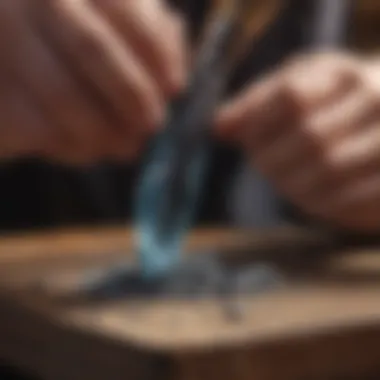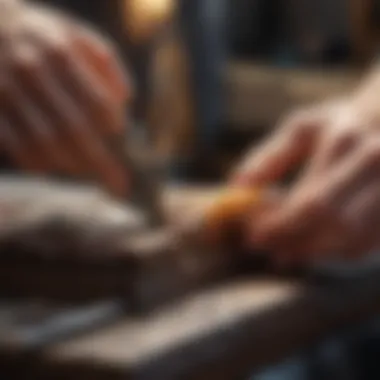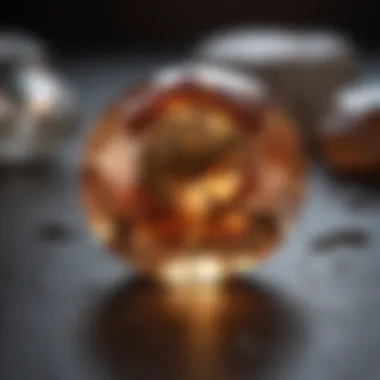Unveiling the Intricacies of Gemstone Carving Tools


Rock and Fossil Identification
Collecting Tips and Techniques
For enthusiasts diving into the world of gemstone carving, mastering the art of collecting is crucial. Best practices for collecting gems include understanding the geological context of prime collecting sites. Knowing how to locate these sites and safely extract specimens is key to preserving the integrity of the stones. By delving into the techniques of proper collection, artisans can ensure that their gemstone creations are sourced ethically and sustainably.
Preservation and Display
After the meticulous process of carving gemstones is complete, the focus shifts to preserving and displaying these prized creations. Techniques for maintaining the vibrancy and integrity of gemstones are essential. Proper storage methods also play a crucial role in extending the longevity of these delicate works of art. To truly showcase the beauty of gemstone carvings, artisans can explore creative display ideas that enhance the aesthetic appeal of their creations.
Geological Insights
Understanding the geological insights behind gemstone formations adds a layer of depth to the art of gemstone carving. By uncovering the geological processes that contribute to the creation of gemstones, artisans gain a deeper appreciation for the historical significance of these rocks and fossils. Notable discoveries in the field of geology further enrich the context within which gemstone carving tools are utilized, highlighting the intricate relationship between natural formations and human craftsmanship.
Introduction to Gemstone Carving Tools
Gemstone carving tools hold a crucial place in the realm of artisanal craftsmanship, enabling the creation of visually captivating and intricate gemstone pieces that captivate the senses. In this article, we delve into the significance of these tools, shedding light on the essential instruments and techniques utilized by skilled artisans to transform raw gemstones into exquisite works of art. From traditional chisels to advanced polishing tools, each tool plays a vital role in the meticulous process of gemstone carving.
Understanding the Art of Gemstone Carving
History and Evolution of Gemstone Carving
The history and evolution of gemstone carving offer a fascinating insight into the art form's rich heritage and cultural significance. Tracing back to ancient civilizations, gemstone carving has evolved from primitive techniques to sophisticated methods, reflecting advancements in craftsmanship and artistic expression. The historical journey of gemstone carving provides artists with a profound connection to tradition while inspiring innovation in contemporary practices.
Significance of Gemstone Carvings in Art and Culture
Gemstone carvings hold a special place in art and culture, symbolizing craftsmanship, beauty, and cultural heritage. These intricately carved gemstones serve as expressions of creativity and skill, transcending time and geographical boundaries. The significance of gemstone carvings lies in their ability to evoke emotions, tell stories, and showcase the masterful techniques passed down through generations. Integrating gemstone carvings into art and culture enriches our aesthetic experiences and deepens our appreciation for fine craftsmanship.
Types of Gemstones Used in Carving
Precious Gemstones
Precious gemstones, with their exceptional rarity and beauty, are revered for their extraordinary quality and value in the realm of gemstone carving. Their allure lies in their unparalleled brilliance, color intensity, and durability, making them ideal for crafting high-end jewelry and artistic masterpieces. Artisans cherish precious gemstones for their ability to transform light and exude elegance, creating timeless pieces that stand the test of time.
Semi-Precious Gemstones


Semi-precious gemstones offer a diverse selection of colors, textures, and affordability, making them popular choices in gemstone carving. These stones, while not as rare as their precious counterparts, possess unique characteristics that appeal to a wide range of artistic expressions. From vibrant hues to earthy tones, semi-precious gemstones provide artisans with versatile options to explore different design concepts and craft visually striking pieces that cater to varying preferences.
Exotic Gemstones
Exotic gemstones encompass a rare and distinctive category of gems that fascinate with their unusual colors, patterns, and properties. These gems, sourced from remote locations around the globe, offer a sense of adventure and mystique to gemstone carvings. Artisans are drawn to exotic gemstones for their rarity and exclusivity, often incorporating them into one-of-a-kind creations that push the boundaries of traditional carving techniques.
Essential Gemstone Carving Tools
Chisels and Gouges
Chisels and gouges form the foundation of gemstone carving tools, providing artisans with precise cutting and shaping capabilities to bring their designs to life. These handheld instruments come in various shapes and sizes, each serving a specific purpose in carving different gemstone materials. From flat chisels for delicate detailing to round gouges for creating contours, artisans rely on the versatility of chisels and gouges to sculpt gemstones with precision and finesse.
Files and Rifflers
Files and rifflers play a crucial role in refining the intricate details of gemstone carvings, smoothing rough edges and shaping contours with precision. These handheld tools come in a range of grits and shapes, allowing artisans to achieve smooth surfaces and sharp edges in their creations. Whether fine-tuning delicate patterns or adjusting proportions, files and rifflers are essential tools that enhance the overall aesthetics and quality of gemstone carvings.
Grinding and Polishing Tools
Grinding and polishing tools are indispensable for achieving the desired finish and luster in gemstone carvings, transforming rough surfaces into gleaming works of art. Diamond grinding wheels offer fast and efficient material removal, while silicon carbide abrasives provide fine finishing touches. Water-cooled grinding systems ensure precision and control during the carving process, while polishing compounds such as alumina oxide and cerium oxide add brilliance and smoothness to the final masterpiece.
Setting and Engraving Tools
Setting and engraving tools are essential for enhancing the intricate details and settings of gemstone carvings, adding depth and dimension to the finished piece. Precision instruments like gauges and calipers ensure accurate stone placements, while prong pushers and burnishers secure gems in their settings with precision. For intricate designs and personalized touch, hand engraving tools, pneumatic engraving systems, and computerized engraving machines offer a range of options to elevate gemstone carvings to new levels of artistry.
Exploring Chisels and Gouges
In this article, the exploration of chisels and gouges holds a pivotal role as these tools are the backbone of gemstone carving craftsmanship. Chisels and gouges are indispensable instruments that allow artisans to shape and form gemstones with intricate precision. By delving into the realm of chisels and gouges, readers gain a deeper understanding of the fundamental tools utilized in gemstone carving, highlighting their significance in achieving exquisite creations.
Types of Chisels for Gemstone Carving
Flat Chisels
Flat chisels are renowned for their versatility and ability to create clean, flat surfaces on gemstones. Their flat edge allows artisans to precisely chip away at material, shaping it according to their artistic vision. The key characteristic of flat chisels lies in their straightforward yet effective design, making them a popular choice for gemstone carvers seeking immaculate finishes. Despite their efficiency, artisans must handle flat chisels with care to avoid unintended fractures or damage to the gemstone surface.
Point Chisels
Point chisels are distinguished by their pointed tip, offering gemstone carvers the precision required for detailed work. The sharp point of these chisels enables artists to create intricate designs and refine edges with accuracy. The key characteristic of point chisels is their ability to access tight spaces and create fine lines, making them essential tools for intricate gemstone carving. However, due to their sharpness, artisans must exercise caution to prevent accidental mishaps during the carving process.


Round Gouges
Round gouges feature a curved cutting edge, ideal for sculpting rounded surfaces and concave areas on gemstones. The key characteristic of round gouges lies in their curved profile, allowing artisans to achieve smooth contours and organic shapes in their carvings. This tool's versatility makes it a valuable asset in creating depth and dimension in gemstone designs. While round gouges excel in sculpting rounded forms, meticulous handling is necessary to avoid overcutting or imprecise shaping of the gemstone.
Diamond Tipped Chisels
Diamond tipped chisels are precision tools equipped with diamond-coated tips for enhanced cutting performance on hard gemstones. The key characteristic of diamond tipped chisels is their exceptional durability and efficiency in carving challenging materials. These chisels are a popular choice for gemstone carvers working with tough gemstones like diamonds, sapphires, and rubies. Their unique feature of diamond-coated tips ensures longevity and consistent cutting quality, although artisans must handle them with care to avoid damaging the gemstone or the tool itself.
Choosing the Right Chisel for Different Gemstones
Hard Gemstones
When working with hard gemstones such as diamonds or sapphires, selecting the appropriate chisel is crucial for effective carving. The key characteristic of hard gemstones is their high resistance to cutting, requiring sturdy tools like diamond tipped chisels for precision carving. While hard gemstones challenge artisans with their durability, the advantage lies in their ability to achieve intricate details and lasting brilliance in carvings. However, due to their hardness, artisans must apply controlled pressure and skillful techniques to avoid potential fractures or breakage during the carving process.
Softer Gemstones
In contrast, softer gemstones like opals or pearls demand a different approach in chisel selection to prevent damage during carving. The key characteristic of softer gemstones is their delicate nature, necessitating the use of gentler tools like flat or point chisels to avoid excessive force that may cause cracking or chipping. While softer gemstones offer ease of carving and shaping, artisans must exercise caution in tool selection and technique application to preserve the gemstone's integrity and luster throughout the carving process.
Textured Gemstones
Textured gemstones present a unique challenge in chisel selection due to their uneven surfaces and intricate patterns. The key characteristic of textured gemstones is their varied structures, requiring specialized tools like round gouges for detailing and shaping. Utilizing round gouges allows artisans to emphasize the gemstone's natural textures and patterns, enhancing visual appeal and depth in the final carving. Despite their complexity, textured gemstones offer artists the opportunity to explore creative techniques and innovative approaches in gemstone carving, showcasing the intrinsic beauty of each unique specimen.
Mastering Grinding and Polishing Techniques
In this section, we dive deep into the crucial aspect of mastering grinding and polishing techniques within the realm of gemstone carving. Understanding the intricacies of grinding and polishing is essential for artisans to transform rough gemstones into exquisite works of art. This topic holds significant relevance in providing insights into the meticulous craftsmanship required to achieve flawless finishes on gemstones.
Grinding Wheels and Abrasives
Diamond Grinding Wheels
Diamond grinding wheels stand out as indispensable tools in gemstone carving due to their exceptional abrasive properties and durability. These wheels are known for their precision in shaping and grinding gemstones with varying hardness levels, ensuring high efficiency and accuracy in the carving process. The key characteristic of diamond grinding wheels lies in their ability to maintain consistent sharpness even when working with the toughest gemstone materials. Their reliability and longevity make them a preferred choice for artisans seeking impeccable results in gemstone carving. Despite their advantages, diamond grinding wheels can be relatively expensive, requiring careful handling to prevent damage during use.
Silicon Carbide Abrasives
Silicon carbide abrasives offer a versatile solution for gemstone carving, known for their effectiveness in grinding and shaping gemstones with medium hardness. A key characteristic of silicon carbide abrasives is their ability to produce smooth and precise finishes on gemstone surfaces, making them a popular choice among artisans. Their affordability and availability make them a practical option for various gemstone carving projects. However, one downside of silicon carbide abrasives is their relatively shorter lifespan compared to diamond grinding wheels, necessitating frequent replacements to maintain optimal performance.


Water Cooled Grinding Systems
Water cooled grinding systems play a vital role in gemstone carving by providing a continuous cool-down effect during the grinding process, preventing overheating and ensuring consistent results. The key characteristic of water cooled systems lies in their ability to dissipate heat quickly, allowing artisans to work on gemstones for extended periods without compromising the material's integrity. This cooling feature not only enhances the efficiency of the grinding process but also minimizes the risk of thermal damage to delicate gemstones. Despite their advantages, water cooled grinding systems may require additional setup and maintenance compared to conventional grinding tools.
Polishing Compounds and Techniques
In the realm of gemstone carving, polishing compounds and techniques are fundamental components for achieving impeccable finishes on carved gemstones. Understanding the nuances of different polishing compounds is essential for artisans looking to elevate the aesthetic appeal of their creations.
Alumina Oxide Polishes
Alumina oxide polishes are renowned for their exceptional polishing capabilities, delivering lustrous finishes on a wide range of gemstones. The key characteristic of alumina oxide polishes is their ability to remove scratches and blemishes effectively, resulting in a glossy and smooth surface texture. Their versatility and ease of application make them a popular choice for artisans seeking to enhance the visual qualities of their gemstone carvings. However, one drawback of alumina oxide polishes is that they can be slightly abrasive, requiring careful handling to avoid over-polishing and potential damage to the gemstone surface.
Cerium Oxide Polishing
Cerium oxide polishing compounds are highly regarded for their superior ability to achieve a mirror-like finish on gemstones, especially those with softer compositions. The key characteristic of cerium oxide polishing lies in its excellent abrasion resistance and high polishing efficiency, ensuring exceptional clarity and shine on gemstone surfaces. Artisans favor cerium oxide polishes for their gentle yet effective polishing action, capable of bringing out the inherent beauty of gemstones without causing excessive wear. Despite their advantages, cerium oxide polishes may require additional buffing to remove residual traces for a flawless finish.
Diamond Polishing Paste
Diamond polishing paste represents the pinnacle of polishing compounds in gemstone carving, revered for its unparalleled ability to achieve perfection in surface polishing. The key characteristic of diamond polishing paste is its ultra-fine abrasive particles, which enable artisans to attain a gleaming, mirror-like polish on even the most challenging gemstone materials. Artisans rely on diamond polishing paste for its precision and consistency in delivering immaculate finishes that enhance the brilliance and clarity of gemstones. However, the high cost of diamond polishing paste may deter some artisans from frequent use, limiting its widespread application in gemstone carving practices.
Section 4: Fine-tuning with Setting and Engraving Tools
In this segment, we delve into the crucial aspects of fine-tuning with setting and engraving tools, highlighting their pivotal role in the meticulous art of gemstone carving. Precision setting instruments play a paramount role in ensuring the intricate details and flawless finish of gemstone creations. These tools not only aid in setting stones securely but also contribute to the overall aesthetic appeal of the final piece.
Precision Setting Instruments
Gauges and Calipers
Gauges and calipers are indispensable tools in the world of gemstone carving, offering artisans the precision measurements necessary for accurate stone placement. The key characteristic of gauges and calipers lies in their ability to provide exact measurements, ensuring symmetrical stone settings and precise alignment. Artisans rely on these tools to achieve uniformity and harmony in their creations, making them a popular choice in the realm of gemstone carving.
One unique feature of gauges and calipers is their versatility in accommodating various gemstone sizes and shapes, allowing artisans to work with a wide range of materials effortlessly. Despite their benefits, these tools require steady hands and meticulous attention to detail to yield impeccable results. Artisans must carefully calibrate their gauges and calipers to achieve the desired accuracy in stone setting.
Prong Pushers
Prong pushers are essential instruments that aid artisans in securing gemstones within their settings with precision and care. The key characteristic of prong pushers lies in their ability to exert controlled pressure on prongs, ensuring a snug fit for the stones while maintaining their durability. Artisans value prong pushers for their practicality and efficiency in setting stones securely.
One unique feature of prong pushers is their ergonomic design, facilitating comfortable handling during the stone-setting process. However, artisans must exercise caution to avoid applying excessive force, which could damage delicate gemstones. Prong pushers offer a balance of strength and delicacy, making them an indispensable tool for artisans seeking to achieve impeccable stone settings.
Burnishers
Burnishers are precision tools that play a crucial role in refining the final look of gemstone creations, providing a smooth and lustrous finish. The key characteristic of burnishers lies in their ability to polish metal settings and push metal edges, ensuring a seamless and professional appearance. Artisans appreciate burnishers for their ability to add a touch of sophistication to gemstone pieces.
One unique feature of burnishers is their versatility in working with different metal types, including gold, silver, and platinum, highlighting intricate details and enhancing the overall design of gemstone settings. However, artisans must exercise caution when using burnishers to avoid over-burnishing, which can distort metal surfaces. With proper technique and skill, burnishers contribute to the refinement and elegance of gemstone creations, elevating their visual appeal and value.







